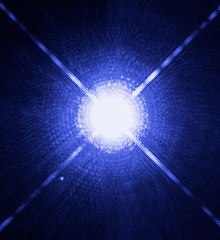
Back Witdwerg Afrikaans Nana blanca AN श्वेत बौना तारा ANP قزم أبيض Arabic Nana blanca AST Ağ cırtdanlar Azerbaijani Белы карлік Byelorussian Бяло джудже Bulgarian শ্বেত বামন Bengali/Bangla Korrez wenn Breton


A white dwarf is a compact star. Their matter is squashed together. Gravitation has pulled the atoms close together, and taken off their electrons. The mass of a white dwarf is similar to the mass of the Sun, but its volume is similar to that of the Earth.
White dwarfs are the final evolutionary state of all stars whose mass is not high enough to become a neutron star. Over 97% of the stars in the Milky Way will become white dwarf stars.[1]§1 After the hydrogen–fusing lifetime of a main-sequence star ends, it will expand to a red giant which fuses helium to carbon and oxygen in its core. If a red giant does not have enough mass to fuse carbon, around 1 billion K, inactive carbon and oxygen will build up at its center. After shedding its outer layers to form a planetary nebula, it will leave behind the core, which is the white dwarf.[2]
The material in a white dwarf no longer undergoes fusion reactions, so the star has no source of energy. It is not supported by the heat of fusion against gravitational collapse.
A star like our Sun will become a white dwarf when it has run out of fuel. Near the end of its life, it will go through a red giant stage, and then lose most of its gas, until what is left contracts and becomes a young white dwarf.
- ↑ Fontaine G; Brassard P. & Bergeron P. 2001. The potential of white dwarf cosmochronology. Astronomical Society of the Pacific 113 (782): 409. [1]
- ↑ Richmond, M. "Late stages of evolution for low-mass stars". Lecture notes, Physics 230. Rochester Institute of Technology. Retrieved 3 May 2007.